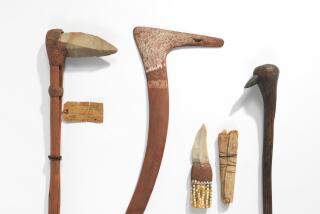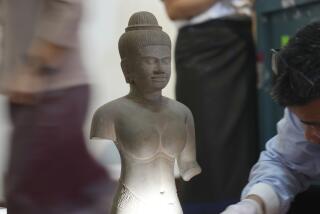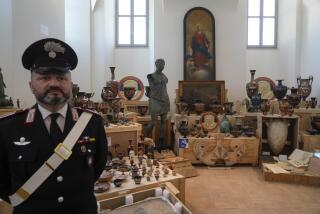Boston Museum Returns 13 Antiquities to Italy
ROME â The Boston Museum of Fine Arts on Thursday formally returned 13 Greek and Roman antiquities to Italy as part of an agreement negotiated over the last five months with Italian officials seeking to recover allegedly looted artifacts from American museums.
The museumâs return of the items, including a life-sized 2nd century white marble statue of Vibia Sabina, one of the hallmarks of its collection, comes days before the J. Paul Getty Museum is scheduled to resume negotiations here over 52 allegedly looted items the Italians want back.
Italian Culture Minister Francesco Rutelli resisted comparisons between the museums, but made it clear that he hoped the Boston museumâs swift deal would increase the pressure on the Getty Museum, the governmentâs biggest target, to reach a resolution.
âI think this agreement can accelerate those that are proceeding more slowly,â Rutelli said at a signing ceremony.
The Boston Museum of Fine Arts is the third major American institution in the last year to commit to a large-scale return of antiquities. In February, the Metropolitan Museum of Art in New York signed a pact promising the return of 21 objects, including a prized 2,500-year-old Greek urn. The Getty pledged in June to surrender a number of âsignificantâ artifacts, but has yet to identify specific items in talks with Italian officials. Italian cultural officials say the two sides remain far apart.
The Boston museum resolved its dispute with Italy in a matter of months. The Gettyâs negotiations have sputtered for at least three years.
The Gettyâs situation is more serious than those faced by the Boston or the New York institutions, said Thomas Hoving, former director of the Metropolitan Museum. Hoving cited financial and legal reasons, particularly that Italian officials had charged former Getty curator Marion True with conspiring to buy looted art.
âNeither Boston nor the Met has a former curator indicted by Italy,â he said. âThereâs the real problem. If they had not indicted Marion True, it would have been an easier path for everybody. It was a strike right at the heart. Thatâs the sticking point.â
In further contrast to the Getty, which faces the loss of tens of millions of dollars it has spent on ancient art, the Boston museum paid $834,000 for the 13 objects, which it purchased between the early 1970s and the late 1990s, records show.
Rutelli said the Gettyâs case was âperhaps a little bit more complicated and a little bit more complex. Itâs huge, huge. But, of course, we are very determined to close such a negotiation.â
A Getty spokesman declined to comment on the museumâs negotiations with Italian officials.
The Boston museum decided to return the 13 items based on evidence from recent criminal investigations, including one that has resulted in the conviction of an Italian antiquities dealer, as well as the allegations against True and a second dealer.
Evidence included Polaroid photographs seized from the dealersâ files of freshly excavated antiquities, some of which show the items broken, dirty and not yet restored.
Officials at the Boston museum said they contacted the Italian Culture Ministry in November after being notified by the media that some of the suspected pieces were in their collection. They were presented with new information in May at a meeting in Rome. They met Italian officials again in July and quickly concluded that the 13 objects belonged to Italy.
The artifacts were crated and shipped from Boston less than a week ago. They include the statue of Sabina, who was the wife of Roman Emperor Hadrian, parts of a candelabrum, ancient Greek water jugs, a mixing bowl, oil flask and other vessels with paintings of gods and dating as far back as 530 BC.
âWhen we acquired these objects, we did it in good faith, and there was not evidence that suggested we could not acquire the objects in good faith. More evidence has come to light,â said Malcolm Rogers, the museumâs director, who signed papers Thursday formalizing the return.
âWe in Boston are committed, alongside the Italian government, to seeing the end of illicit excavations and the illicit trade in antiquities,â Rogers said.
Confidential records show that the Italian Culture Ministry also had inquired about four dozen other items in the Boston collection.
The objects had been sold to the museum by dealers known to handle looted art.
But when both parties failed to find additional information about the objects, the pieces were dropped from the deal negotiations, Italian officials said.
Culture Ministry officials said the Boston agreement was a broader pact than the one signed this year by the Metropolitan Museum of Art. The New York museum insisted the Italian government make loans of comparable antiquities to replace each of the returned objects, but the Boston agreement includes only one loan to compensate for the loss of the Sabina statue.
The agreement allows for the Italian Culture Ministry to lend antiquities to the Boston museum for two upcoming exhibits about Venice during the Renaissance and artistic treasures from the Bay of Naples.
âWe know those loans are going to happen,â Rogers said. âWeâre talking about true collaboration, and not an eye-for-an-eye and tooth-for-a-tooth.â
Rutelli would not say what the Culture Ministry would offer the Boston museum, but an announcement probably will be made when he visits Boston in November.
More to Read
The biggest entertainment stories
Get our big stories about Hollywood, film, television, music, arts, culture and more right in your inbox as soon as they publish.
You may occasionally receive promotional content from the Los Angeles Times.










